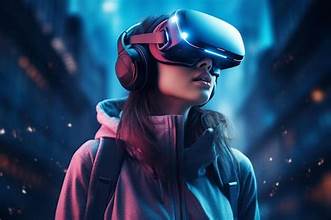Virtual Reality (VR) 2.0 is revolutionizing digital experiences, delivering unprecedented immersion and interactivity that redefine human-computer interaction. The next generation of VR technology integrates cutting-edge advancements in hardware, software, and connectivity, providing users with lifelike simulations that transcend traditional boundaries. This innovation is not just about gaming or entertainment; it is about unlocking new dimensions of possibilities across industries.
The Evolution of Virtual Reality: From Concept to VR 2.0
Virtual Reality has come a long way since its inception, evolving from rudimentary simulations into hyper-realistic experiences with Virtual Reality VR 2.0. Early VR systems were limited by clunky hardware, low-resolution displays, and restricted movement. These early limitations prevented widespread adoption despite the technology’s promise.
VR 2.0 has redefined these experiences by introducing high-definition visuals, responsive motion tracking, and wireless capabilities. Users now enjoy seamless interaction in virtual environments, enabling immersion that feels indistinguishable from reality. Enhanced processing power, improved sensors, and intuitive interfaces have pushed the boundaries of what VR can achieve, opening new avenues for exploration.
The Technological Foundations of VR 2.0
The advancements driving VR 2.0 stem from innovations in hardware and software that deliver an unparalleled user experience. Modern headsets feature high-resolution OLED or AMOLED displays, providing vibrant visuals with minimal latency and superior field-of-view. Motion controllers equipped with haptic feedback offer tactile engagement, creating a physical connection between users and their virtual surroundings.
Artificial intelligence and machine learning algorithms power VR 2.0, enabling adaptive environments that respond dynamically to user behavior. These technologies enhance realism by simulating natural interactions, making virtual experiences feel authentic. Additionally, 5G connectivity ensures low-latency streaming, enabling collaborative VR sessions and multiplayer interactions without interruption.
Applications of VR 2.0 Across Industries
VR 2.0 extends far beyond entertainment, transforming industries with applications that enhance productivity, training, and engagement. In healthcare, VR 2.0 enables surgical simulations that allow medical professionals to refine techniques in risk-free settings. This approach improves patient outcomes and reduces errors, revolutionizing the medical training landscape.
In education, VR 2.0 offers students immersive learning experiences, such as exploring historical landmarks or conducting virtual science experiments. This technology fosters interactive learning, making abstract concepts tangible and captivating. Similarly, architects and designers use VR 2.0 to create 3D visualizations, allowing clients to experience spaces before construction begins.
Retail and e-commerce also benefit, with VR 2.0 enabling virtual try-ons and immersive shopping environments that enhance customer satisfaction. From real estate tours to virtual sports training, VR 2.0 empowers industries to reimagine their processes and user interactions.
Immersive Gaming in the Era of VR 2.0
Gaming remains one of the most prominent applications of VR 2.0, providing players with experiences that blur the line between the physical and virtual worlds. Developers leverage advancements in VR hardware and software to craft narratives and environments that engage players like never before.
Games designed for VR 2.0 offer unparalleled realism, allowing players to feel as if they are part of the story. Interactive environments, motion-based gameplay, and realistic physics make these games deeply engaging. Multiplayer VR experiences also promote social interaction, fostering a sense of community among gamers across the globe.
The Role of AI in Enhancing VR 2.0
Artificial intelligence is a cornerstone of VR 2.0, driving intelligent systems that adapt to users’ preferences and actions. AI algorithms process user inputs to create personalized experiences, tailoring environments, narratives, and challenges based on individual behavior.
Through machine learning, VR 2.0 environments become more realistic by incorporating predictive modeling and object recognition. These advancements enable dynamic interactions, such as characters responding naturally to user movements and dialogue. By blending AI with VR, developers achieve immersive worlds that evolve seamlessly with user engagement.
Overcoming Challenges in VR 2.0 Development
Despite its advancements, VR 2.0 faces challenges that developers and researchers work tirelessly to overcome. One primary obstacle is motion sickness, often caused by discrepancies between visual stimuli and physical movement. Engineers counter this issue by optimizing frame rates, reducing latency, and improving head-tracking accuracy.
Cost remains another barrier to widespread adoption, as high-quality VR equipment can be expensive for consumers and businesses. However, ongoing research into cost-effective materials and manufacturing processes aims to make VR 2.0 accessible to broader audiences.
Compatibility is another consideration, as developers strive to create systems that work seamlessly across various devices and platforms. Addressing these challenges ensures the continued growth and accessibility of VR 2.0.
The Future of Social Interaction with Virtual Reality 2.0
Virtual Reality 2.0 redefines social interaction, offering platforms where users connect and collaborate in shared virtual spaces. Virtual meeting rooms, social events, and collaborative work environments are becoming standard, especially in remote work scenarios. These platforms enable face-to-face communication without physical presence, fostering connectivity.
Social VR applications incorporate realistic avatars, spatial audio, and natural gestures, ensuring lifelike interactions. With VR 2.0, global teams can brainstorm, create, and innovate without geographical constraints, bridging the gap between digital and physical collaboration.
Ethical Considerations in Virtual Reality 2.0
As VR 2.0 becomes increasingly integrated into daily life, ethical concerns regarding data privacy, content regulation, and user well-being arise. Immersive environments collect significant amounts of user data, raising questions about how this information is stored, used, and shared.
Content moderation becomes vital as users spend more time in virtual spaces. Developers must ensure VR experiences are inclusive, non-discriminatory, and free from harmful content. Additionally, the psychological impact of spending extended periods in VR requires careful consideration to safeguard users’ mental health.
The Role of Virtual Reality 2.0 in Shaping the Metaverse
VR 2.0 is a cornerstone of the metaverse, an interconnected virtual world where users interact, socialize, and conduct business. By providing immersive interfaces, VR 2.0 enables users to navigate and participate in these digital ecosystems seamlessly.
The metaverse thrives on VR 2.0’s capabilities, from realistic avatars to interactive spaces that mirror real-world activities. Businesses leverage the metaverse to host virtual storefronts, events, and collaborations, redefining how we experience digital landscapes. The metaverse’s growth underscores VR 2.0’s transformative potential.
The Psychological Impact of Virtual Reality 2.0
Virtual Reality 2.0 influences the human psyche profoundly, offering both benefits and challenges to mental health. Immersive experiences can reduce stress by providing escapism, relaxation, and therapeutic applications, such as treating phobias or PTSD.
However, prolonged use of VR raises concerns about disconnection from reality and potential addiction. Developers must balance immersion with safeguards that encourage healthy usage patterns. The psychological implications of VR 2.0 warrant continued study to ensure its benefits outweigh its risks.
FAQs
What sets Virtual Reality 2.0 apart from traditional VR?
VR 2.0 introduces advanced features like high-resolution visuals, low-latency interactions, and AI-driven personalization for an unparalleled experience.
Can Virtual Reality 2.0 be used in education?
Yes, VR 2.0 enhances learning by providing immersive environments, making complex subjects like history or science engaging and interactive.
Is Virtual Reality 2.0 suitable for all age groups?
While VR 2.0 is generally safe, age-appropriate content and moderation are essential for ensuring positive experiences for users.
Does Virtual Reality 2.0 require a high-speed internet connection?
Yes, VR 2.0 benefits from high-speed connectivity, especially for multiplayer and cloud-based applications, ensuring seamless and immersive experiences.
What industries can benefit most from Virtual Reality 2.0?
VR 2.0 transforms industries like healthcare, education, gaming, architecture, and retail by providing innovative tools and immersive solutions.
How affordable is Virtual Reality 2.0 technology?
While VR 2.0 equipment can be costly, ongoing advancements aim to make devices more affordable and accessible to everyone.
Conclusion
Virtual Reality 2.0 marks a pivotal moment in technological advancement, redefining how we interact with digital environments and each other. Its innovative applications extend across industries, enhancing productivity, education, entertainment, and social connectivity. As VR 2.0 continues to evolve, it promises to unlock new realms of creativity, collaboration, and innovation. By embracing this transformative technology responsibly, we step closer to a future where virtual and physical realities seamlessly coexist.











